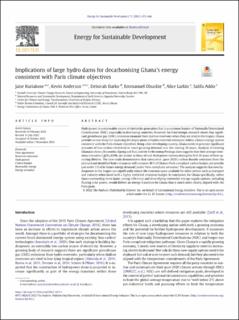| dc.contributor.author | Kuriakose, Jaise | |
| dc.contributor.author | Anderson, Kevin | |
| dc.contributor.author | Darko, Deborah | |
| dc.contributor.author | Obuobie, Emmanuel | |
| dc.contributor.author | Larkin, Alice | |
| dc.contributor.author | Addo, Salifu | |
| dc.date.accessioned | 2022-12-29T14:14:48Z | |
| dc.date.available | 2022-12-29T14:14:48Z | |
| dc.date.created | 2022-11-29T13:10:31Z | |
| dc.date.issued | 2022 | |
| dc.identifier.issn | 0973-0826 | |
| dc.identifier.uri | https://hdl.handle.net/11250/3039928 | |
| dc.description.abstract | Hydropower is a renewable source of electricity generation that is a common feature of Nationally Determined Contributions (NDC), especially in developing countries. However, far from benign, research shows that significant greenhouse gas (GHG) emissions emanate from shallow reservoirs when they are sited in the tropics. Ghana provides a case study for exploring the implications of hydro reservoir emissions within a future energy system consistent with the Paris climate objectives. Being a fast-developing country, Ghana needs to generate significant amounts of low-carbon electricity to meet growing demand over the coming 30 years. Analysis of existing Ghanaian dams (Akosombo, Kpong and Bui) and the forthcoming Pwalugu dam suggests that their average emissions intensities (gCO2/kWh) are similar to those of coal-fired power stations during the first 30 years of their operating lifetime. The case study demonstrates that cumulative (post-2020) carbon dioxide emissions from the planned and identified hydro resources will consume 40 % of Ghana's Paris-compliant carbon budget, yet provide just under 1 % of its future energy demand (under Paris-compliant scenarios). The analysis suggests that new hydropower in the tropics can significantly reduce the emission space available for other sectors such as transport and industry when faced with a highly restricted emissions budget. In conclusion, for Ghana specifically, rather than constructing more dams, energy efficiency and diversifying renewable energy supply options, including floating solar power, would deliver an energy transition for Ghana that is much more closely aligned with the Paris goals. | en_US |
| dc.language.iso | eng | en_US |
| dc.publisher | Elsevier | en_US |
| dc.rights | Navngivelse 4.0 Internasjonal | * |
| dc.rights.uri | http://creativecommons.org/licenses/by/4.0/deed.no | * |
| dc.title | Implications of large hydro dams for decarbonising Ghana's energy consistent with Paris climate objectives | en_US |
| dc.type | Journal article | en_US |
| dc.type | Peer reviewed | en_US |
| dc.description.version | publishedVersion | en_US |
| dc.rights.holder | Copyright 2022 the authors | en_US |
| cristin.ispublished | true | |
| cristin.fulltext | original | |
| cristin.qualitycode | 1 | |
| dc.identifier.doi | 10.1016/j.esd.2022.10.011 | |
| dc.identifier.cristin | 2084009 | |
| dc.source.journal | Energy for Sustainable Development | en_US |
| dc.source.pagenumber | 433-446 | en_US |
| dc.identifier.citation | Energy for Sustainable Development. 2022, 71, 433-446. | en_US |
| dc.source.volume | 71 | en_US |

